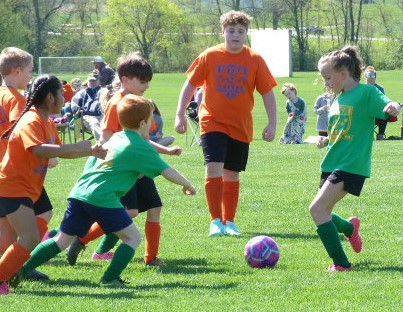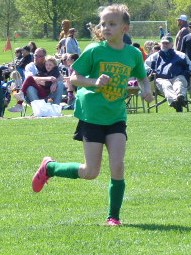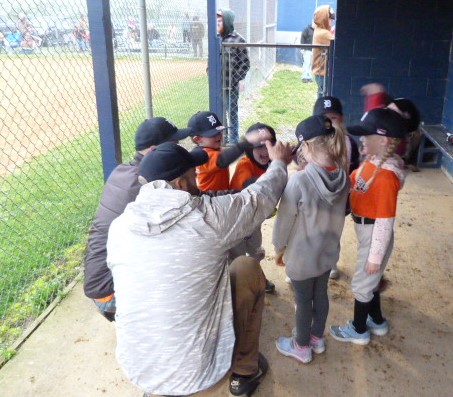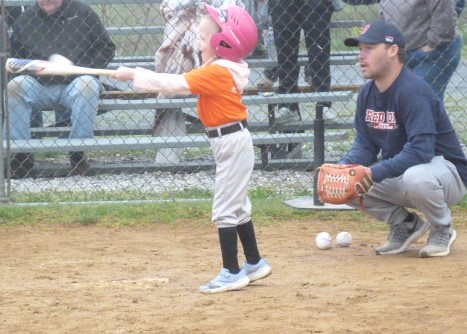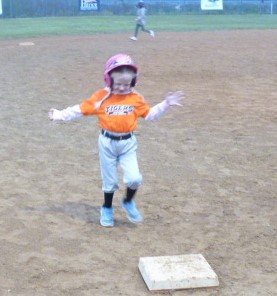On a chilly, breezy Friday evening at the Pen Mar Youth League fields in Blue Ridge Summit, the Pesanti family watches five-year-old Lily Pesanti play in her second T-Ball game. The pride of the Tigers, coached by her father Alan, the expression on her face when running the bases tells it all.
The next morning, the oldest daughter, Bailey, will play a soccer game for Caledonia Golf Club at the Robert E. Stum Soccer Complex on Country Club Road in Waynesboro. Bailey, who turned eight on March 29, is a veteran of youth soccer, having played in the spring and fall since she was four years old.
Soon, it will all be just a memory.
Nobody knows if Bailey will continue to play soccer into middle school and high school – or if Lily will take a liking to softball in the future. All that matters is now. All that matters, for that matter, is living in the moment, making memories, and enjoying the experience.
Their mother, Kara, was a cheerleader from middle school through high school. She was the cheer captain in her senior year, and she was also in competitive cheer. Alan played youth baseball and was an avid bowler.
According to an article titled Parental Involvement in Youth Sports, “A moderate degree of parental involvement is important as it communicates interest and support to the child. Children’s perceptions of parental support and involvement in physical activity have been identified as positive predictors of enjoyment, participation in physical activity, and continued participation in youth sports.”
The key word is “moderate.” The article goes on to state, “A growing concern amongst those involved in youth sports is that certain aspects of parental involvement are detrimental to the development and experiences of young athletes.”
Perhaps T-ball is the last bastion of innocence when it comes to parental involvement and spectator behavior. Expectation of victory is absent. Gentle prodding is acceptable when it comes to fielders fielding and baserunners running.
At the Pen Mar Little League field, there is a sign that admonishes all who read it: “Before you complain, have you volunteered yet?”
The number one rule of T-ball is “one base at a time.” Batters get four chances to hit a softly thrown pitch by their team’s coach. If they can’t hit the ball, the T is placed on home plate, and when the ball is hit, the fun begins. Infielders scramble to field the ball, and, on a good play, the ball reaches first base. Otherwise, it’s always one base at a time.
After the last batter comes to the plate and hits the ball, all base runners run the cycle and race home. Some players chart their own course and run across the infield oblivious to teammates following the imaginary line around the bases.
In T-ball, it’s a player’s world, and the adults are in it. It’s safe to say that when the kids get home and return to their days, they probably forget what they just did. But, at the moment, on the field, amid laughter and chatter, life is fun. Time stands still for all attending the contest. The game is just a game. There are no winners and losers. Instead, all is a building block. Some children, perhaps, bookmark the time they ran the bases and threw the ball – and recall it sometime in the future when they play in a youth league game.
For others, it’s a time when they made friends, a time when they learned to listen to instructions from a grown-up. For some, it is their first exposure to an organized team event. For the coaches, it’s a time for patience and a sense of nurturing – not with the aim of teaching children (anywhere from ages four to six years old) how to be competitive and with a goal to win – but to play.
Games last an hour, other times less than an hour. It’s time well spent for families because nothing is at stake. No winning. No losing. Only fun. The bittersweet thing about it all is that, before long, the future arrives. The children become adolescents, and that time Lily played her last T-ball game and Bailey became a middle schooler, and laughter turned to tears at the recollection of children growing older, there was a satisfaction and pride in knowing that mom and dad were there, in the middle of their children’s lives.
And they did it the right way.
“Parents must not lose sight of why youth participate in sport. A study of over 25,000 children from across the US revealed that the most popular reason for playing youth sports was ‘to have fun’. The next most popular reasons for playing sports were to learn new skills, to be with friends, and to experience the thrill of competition. Although the children did identify winning as a reason for playing sport it was not one of the most popular reasons. Many parents erroneously believe that winning is the number one reason that children want to play sports. Parents who become preoccupied with winning and losing place an unreasonable amount of pressure on their child and risk turning their child off to youth sports.” (Parental Involvement in Youth Sports: The Good, the Bad and the Ugly)
